HOT ROLLED STEEL EQUAL ANGLE for construction JIS G3192
- Loading Port:
- Tianjin
- Payment Terms:
- TT or LC
- Min Order Qty:
- 25 m.t.
- Supply Capability:
- 100000 m.t./month
OKorder Service Pledge
OKorder Financial Service
You Might Also Like
Product Description:
OKorder is offering hot rolled steel equal angle for construction JIS G3192at great prices with worldwide shipping. Our supplier is a world-class manufacturer of steel, with our products utilized the world over. OKorder annually supplies products to European, North American and Asian markets. We provide quotations within 24 hours of receiving an inquiry and guarantee competitive prices.
Product Applications:
Hot rolled steel equal angle are ideal for structural applications and are widely used in the construction of buildings and bridges, and the manufacturing, petrochemical, and transportation industries.
Product Advantages:
OKorder's steel equal angle are durable, strong, and resist corrosion.
Main Product Features:
· Premium quality
· Prompt delivery & seaworthy packing (30 days after receiving deposit)
· Corrosion resistance
· Can be recycled and reused
· Mill test certification
· Professional Service
· Competitive pricin
Product Specifications:
1. Invoicing on theoretical weight or actual weight as customer request
2. Length: 6m, 9m, 12m as following table
3. Sizes
:
5. Payment terms:
1).100% irrevocable L/C at sight.
2).30% T/T prepaid and the balance against the copy of B/L.
3).30% T/T prepaid and the balance against L/C
FAQ:
Q1: How do we guarantee the quality of our products?A1: We have established an advanced quality management system which conducts strict quality tests at every step, from raw materials to the final product. At the same time, we provide extensive follow-up service assurances as required.
Q2: How soon can we receive the product after purchase
A2: Within three days of placing an order, we will begin production. The specific shipping date is dependent upon international and government factors, but is typically 7 to 10 workdays.
Images:



- Q:How do you calculate the compression strength of a steel angle?
- To calculate the compression strength of a steel angle, you need to consider its geometric properties and the material properties of the steel. First, you should determine the cross-sectional area of the steel angle. This can be calculated by multiplying the thickness of the angle by the width of the flange and subtracting the area of any holes or cutouts in the angle. Next, you need to determine the yield strength of the steel. The yield strength is the maximum stress that the steel can withstand before it starts to deform permanently. This information can usually be obtained from the steel manufacturer or reference materials. Once you have the cross-sectional area and the yield strength, you can calculate the compression strength using the formula: Compression strength = Yield strength * Cross-sectional area It's important to note that this calculation assumes that the steel angle is subjected to a purely compressive load, without any bending or torsional forces. If the angle is subjected to other types of loading, such as bending or torsion, additional calculations or testing may be required to accurately determine its strength.
- Q:What are the different types of steel angles?
- There are several different types of steel angles, each designed for specific applications and purposes. Some of the common types include: 1. Equal angle: This type of steel angle has equal sides and is widely used in construction for structural support, bracing, and framing. 2. Unequal angle: Also known as L-shaped or unequal leg angle, this type of steel angle has unequal sides, with one longer side and one shorter side. It is commonly used in building construction to create corners, edges, and supports. 3. Stainless steel angle: Made from stainless steel, this type of angle offers excellent corrosion resistance and is commonly used in applications where exposure to moisture or chemicals is a concern, such as in marine environments or food processing facilities. 4. Galvanized angle: Galvanized steel angles are coated with a layer of zinc to provide protection against rust and corrosion. They are commonly used in outdoor and industrial applications where durability is essential. 5. Slotted angle: Slotted steel angles have holes or slots along their length, allowing for easy attachment and adjustment of components. They are commonly used in shelving systems, storage racks, and DIY projects. 6. Rolled steel angle: This type of angle is created by rolling steel into a specific shape, resulting in a uniform and smooth surface. Rolled steel angles are often used in manufacturing, machinery, and structural applications. 7. Structural angle: Structural steel angles are designed to bear heavy loads and provide structural support in construction projects. They are often used in building frames, bridges, and other infrastructure projects. These are just a few examples of the different types of steel angles available. The choice of angle will depend on the specific requirements of the project, including load capacity, corrosion resistance, and aesthetic considerations. Consulting with a professional or structural engineer can help determine the most suitable type of steel angle for a particular application.
- Q:How do you determine the required thickness of a steel angle for a specific application?
- To determine the required thickness of a steel angle for a specific application, several factors need to be considered. Firstly, it is essential to determine the load or weight that the steel angle will be subjected to. This includes both the dead load (the weight of the steel angle itself) as well as any live loads (external forces or loads applied to the angle). Next, the span or distance between supports needs to be determined. The greater the span, the higher the bending moment and deflection that the steel angle will experience. Once the load and span are known, it is necessary to calculate the maximum allowable stress or bending moment that the steel angle can withstand. This is typically done using engineering formulas or structural analysis software. The maximum allowable stress is determined based on the steel's yield strength and safety factors. Using the maximum allowable stress and the bending moment, the required section modulus of the steel angle can be calculated. The section modulus is a measure of the angle's resistance to bending and is directly related to its thickness. Finally, the required thickness of the steel angle can be determined by selecting a standard angle size that has a section modulus equal to or greater than the calculated value. It is crucial to note that other considerations, such as corrosion protection, fire resistance, and aesthetics, may also influence the selection of the steel angle thickness. Therefore, consulting structural engineers or following relevant building codes and standards is highly recommended to ensure the safety and performance of the steel angle in a specific application.
- Q:What are the common surface treatments for steel angles to enhance corrosion resistance?
- There are several common surface treatments for steel angles that are used to enhance corrosion resistance. These treatments include: 1. Galvanizing: This is one of the most popular methods used to protect steel angles from corrosion. Galvanizing involves applying a layer of zinc to the surface of the steel through a process called hot-dip galvanizing. The zinc coating acts as a barrier, preventing moisture and corrosive substances from reaching the underlying steel. 2. Paint or Powder Coating: Applying a layer of paint or powder coating to the surface of steel angles can provide an additional layer of protection against corrosion. The paint or powder coating acts as a barrier, preventing exposure to moisture and other corrosive elements. This method is commonly used in applications where aesthetics are important, as it allows for a wide range of color options. 3. Phosphating: Phosphating involves applying a thin layer of zinc or manganese phosphate to the surface of the steel angle. This treatment creates a protective layer that enhances corrosion resistance by providing a barrier between the steel and corrosive substances. 4. Chromate Conversion Coating: This process involves immersing the steel angle in a solution containing chromates, which forms a thin layer of chromate conversion coating on the surface. This coating provides corrosion resistance by acting as a barrier against moisture and other corrosive elements. 5. Mechanical Finishing: Mechanical finishing techniques such as shot blasting or sandblasting can be used to remove any existing rust or scale from the surface of the steel angle. This process helps to improve the adhesion of subsequent coatings and treatments, thereby enhancing corrosion resistance. It is important to note that the choice of surface treatment for steel angles depends on the specific application, environmental conditions, and desired level of corrosion resistance. Consulting with a corrosion specialist or professional in the field can help determine the most suitable treatment for a particular situation.
- Q:Can steel angles be used in load-bearing columns?
- Load-bearing columns can indeed utilize steel angles. Construction frequently incorporates steel angles due to their robustness and longevity. These angles offer structural reinforcement and support for load-bearing columns. Compared to alternative materials, the angle shape of steel enhances stability and load-bearing capacity. In the construction industry, steel angles find widespread application in buildings, bridges, and various structures necessitating load-bearing columns.
- Q:Can steel angles be customized to specific dimensions?
- Yes, steel angles can be customized to specific dimensions. Steel angles are commonly used in construction and manufacturing industries, and they can be customized to meet the specific requirements of a project. This customization can include altering the length, width, and thickness of the steel angle to fit the desired dimensions. By working with a steel fabrication company or a metal supplier, customers can provide their specific measurements and requirements, and the steel angles can be custom-made accordingly. This ensures that the steel angles are tailored to the needs of the project, providing a precise fit and optimal performance.
- Q:What are the different types of steel angles used in manufacturing?
- In manufacturing, a variety of steel angles are utilized, each possessing unique characteristics and applications. Some commonly encountered types include: 1. Equal Angle: This steel angle features equal sides and angles, forming a 90-degree angle. It finds frequent use in structural applications where strength and stability are paramount, such as framing and supports. 2. Unequal Angle: As its name implies, this steel angle possesses unequal sides and angles. It is often employed in applications necessitating varying load-bearing capacities or the creation of different shapes during manufacturing processes. 3. L-Angle: This steel angle, also referred to as L-shaped angles, exhibits a 90-degree bend with unequal sides. It sees common use in reinforcing corners, as well as in construction and fabrication projects. 4. T-Angle: T-angles possess a T-shaped cross-section, with one side extending vertically and the other horizontally. They are frequently utilized as structural supports or in applications requiring additional strength and rigidity. 5. Flat Bar Angle: This steel angle possesses a flat surface on one side and a right-angle bend on the other. It is commonly employed for bracing, supports, and framing in manufacturing and construction projects. 6. Slotted Angle: Slotted angles are characterized by having holes or slots running along their length, allowing for convenient adjustment and customization. They find regular use in shelving, racks, and storage systems within manufacturing and warehouse environments. These examples merely scratch the surface of the diverse range of steel angles employed in manufacturing. The specific type chosen depends on project requirements such as load-bearing capacity, structural integrity, and desired shape or configuration.
- Q:What are the tolerance specifications for steel angles?
- The tolerance specifications for steel angles vary depending on the specific standards and requirements set by the industry or application. These specifications typically include tolerances for dimensions such as length, width, and thickness, as well as tolerances for straightness, squareness, and surface finish. It is important to refer to the relevant standards or consult with manufacturers to determine the exact tolerance specifications for steel angles in a particular context.
- Q:How do you calculate the effective length of a steel angle?
- To calculate the effective length of a steel angle, you need to consider its end conditions and support conditions. It is determined by analyzing the buckling behavior and stability of the angle under different loading conditions. This involves considering factors such as fixed or pinned ends, bracing conditions, and the angle's geometric properties. By applying relevant formulas or structural analysis methods, you can determine the effective length and use it to assess the angle's structural stability and design requirements.
- Q:How do steel angles contribute to the overall stability of a truss system?
- Steel angles play a critical role in enhancing the overall stability of a truss system, which is widely utilized in structural applications like bridges and buildings to efficiently distribute loads and provide support. The stability of a truss system relies on the steel angles within it. Firstly, the truss system commonly incorporates steel angles as diagonal members, aiding in resisting both tensile and compressive forces that act on the structure. By strategically placing these steel angles, the truss system gains resistance against lateral loads like wind or seismic forces, which can potentially lead to the structure swaying or collapsing. The diagonal angles effectively transfer these loads to the vertical and horizontal members of the truss, ensuring the stability of the entire system. Furthermore, steel angles contribute to stability by preventing the buckling or twisting of truss members. Buckling refers to the sudden failure of a structural member under compressive stress, while twisting refers to the rotational deformation caused by lateral forces. By incorporating steel angles as bracing elements, the truss system becomes more resistant to these types of deformations. The angles act as rigid supports, preventing the members from buckling or twisting, thus enhancing the overall stability of the truss system. Moreover, steel angles aid in increasing the rigidity of the truss system, which refers to its stiffness and resistance to deformation. By connecting various truss members with steel angles, the overall rigidity of the truss system is improved. This increased rigidity allows the truss to bear heavier loads, providing overall stability and durability to the structure. In conclusion, steel angles are crucial in contributing to the overall stability of a truss system. They provide resistance against lateral loads, prevent buckling and twisting of members, and increase the rigidity of the structure. By strategically incorporating steel angles within a truss system, engineers can ensure the stability and strength of the structure, enabling it to withstand various external forces.
1. Manufacturer Overview |
|
|---|---|
| Location | |
| Year Established | |
| Annual Output Value | |
| Main Markets | |
| Company Certifications | |
2. Manufacturer Certificates |
|
|---|---|
| a) Certification Name | |
| Range | |
| Reference | |
| Validity Period | |
3. Manufacturer Capability |
|
|---|---|
| a)Trade Capacity | |
| Nearest Port | |
| Export Percentage | |
| No.of Employees in Trade Department | |
| Language Spoken: | |
| b)Factory Information | |
| Factory Size: | |
| No. of Production Lines | |
| Contract Manufacturing | |
| Product Price Range | |
Send your message to us
HOT ROLLED STEEL EQUAL ANGLE for construction JIS G3192
- Loading Port:
- Tianjin
- Payment Terms:
- TT or LC
- Min Order Qty:
- 25 m.t.
- Supply Capability:
- 100000 m.t./month
OKorder Service Pledge
OKorder Financial Service
Similar products
New products
Hot products
Related keywords




























